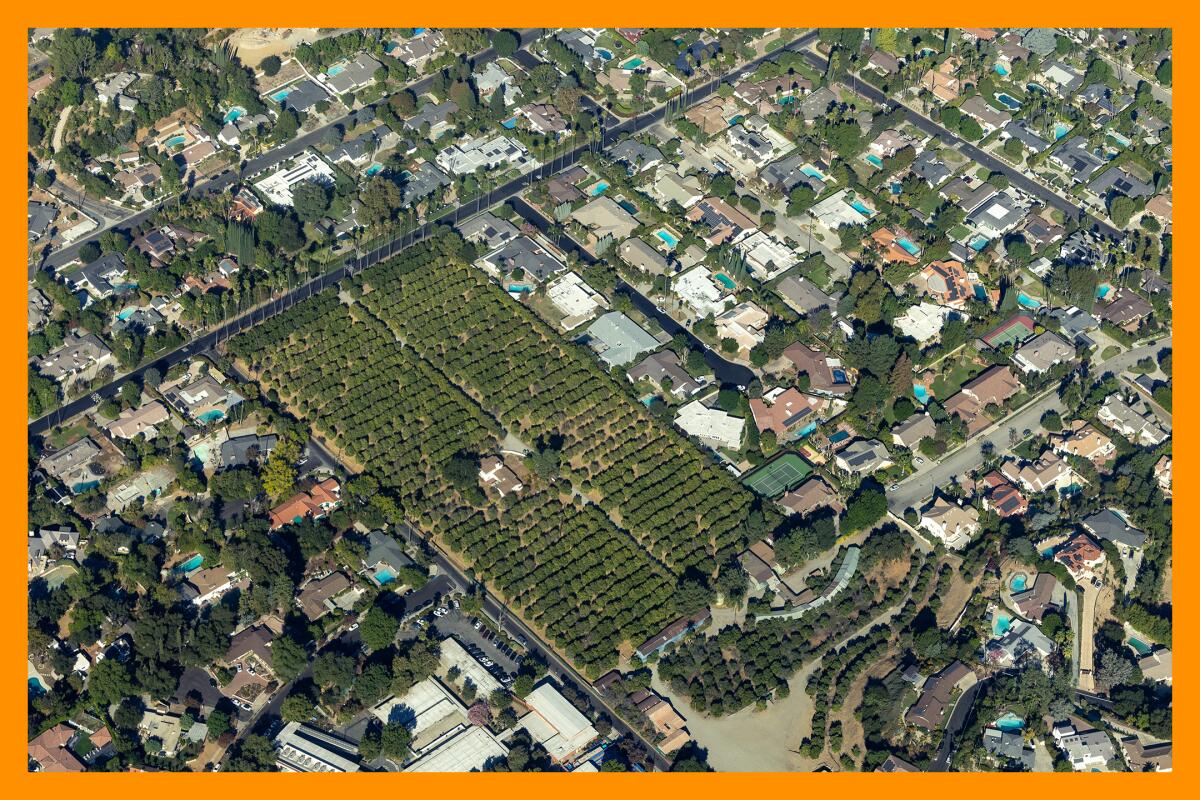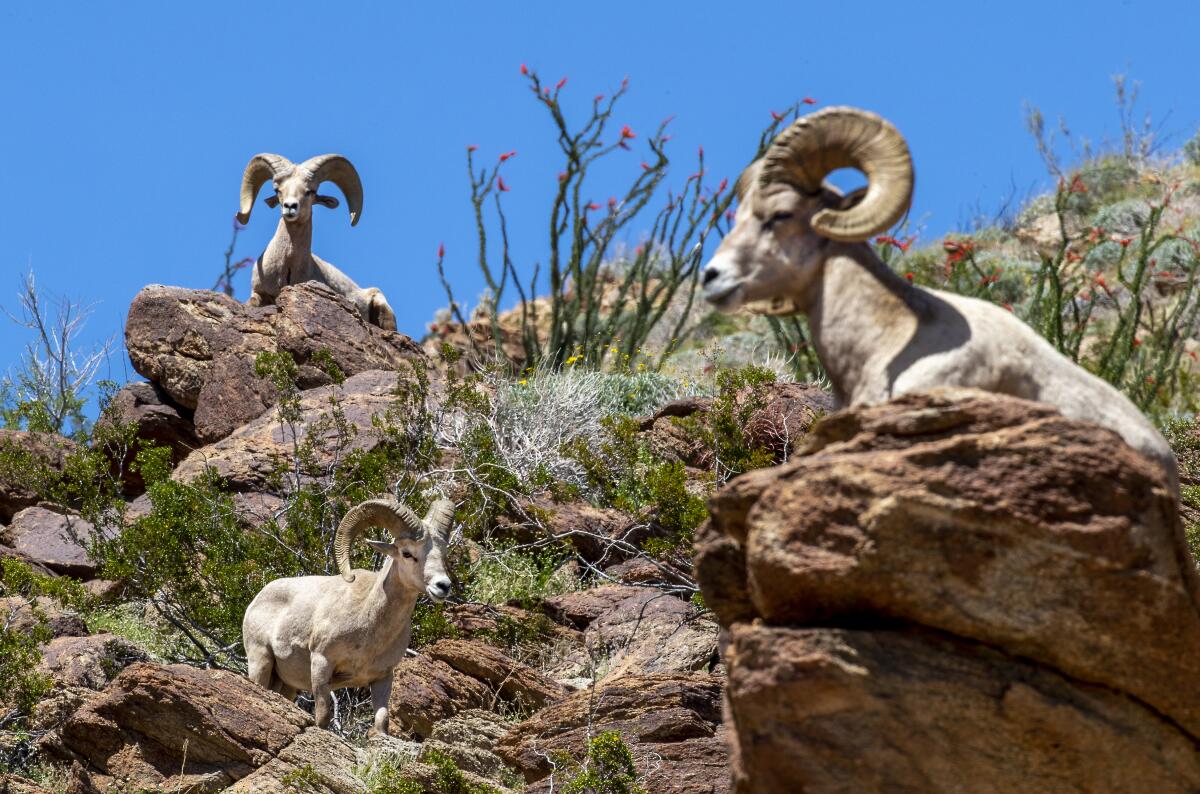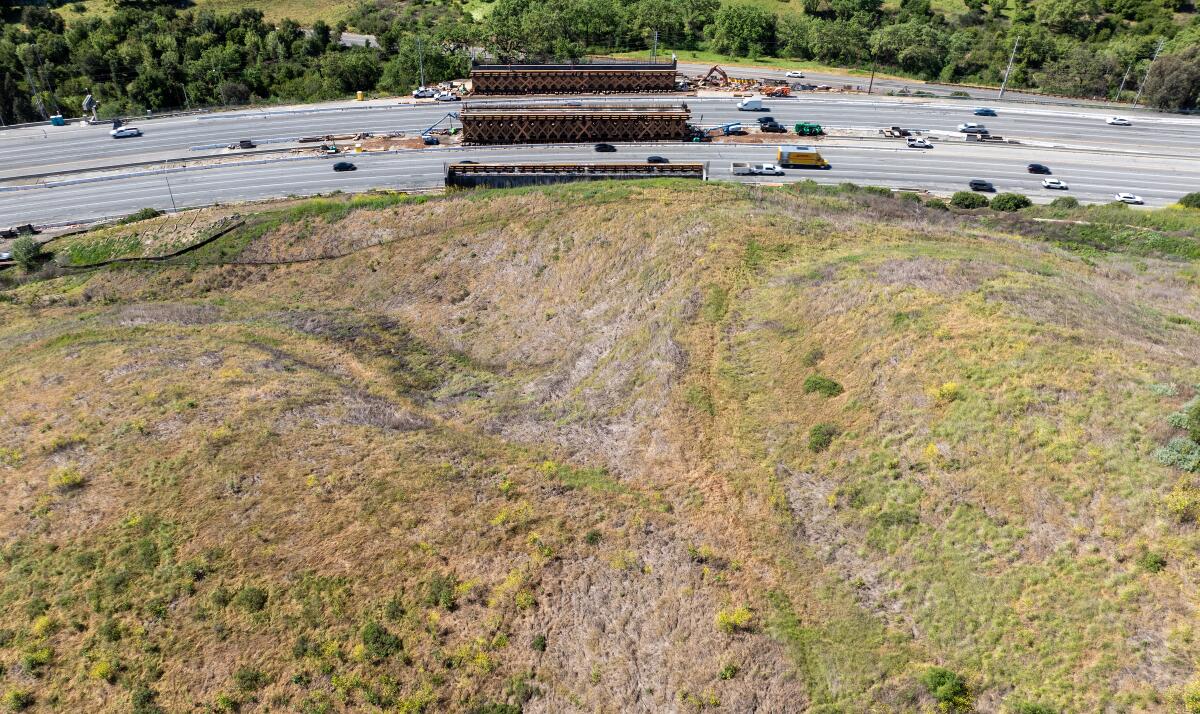As our small plane flew over the San Fernando Valley, I was in awe of just how remarkable and diverse the region’s wild lands are.
I smiled remembering all the hikes I’ve taken in this area, also known as the Rim of the Valley corridor. I’ve huffed and puffed up the steep Verdugo Mountains on the eastern side of the valley, playing on boulders in the Simi Hills and Santa Susana Mountains. I’ve stood in awe of ocean views from high above in the Santa Monica Mountains.

Homes in the foothills of the Verdugo Mountains in the east San Fernando Valley, seen on an EcoFlight tour of the region.
(Brian van der Brug / Los Angeles Times)
But the biggest takeaway from that flight — hosted by nonprofits National Parks Conservation Association and EcoFlight — was just how developed the area around the Rim of the Valley is. When I joined the group for a tour of the region on Oct. 22, I saw thousands of homes (including a mansion with a Lakers-themed basketball court) and businesses drawing ever nearer to the foothills of our local ranges. It was witnessing that creeping urban sprawl from thousands of feet up that helped me understand why advocates are urging legislators to protect it.
Newsletter
You are reading The Wild newsletter
Sign up to get expert tips on the best of Southern California’s beaches, trails, parks, deserts, forests and mountains in your inbox every Thursday
You may occasionally receive promotional content from the Los Angeles Times.
For decades environmental activists and elected officials have tried to pass legislation that would add thousands of acres of the Rim of the Valley corridor to the Santa Monica Mountains National Recreation Area.
The concept was originally imagined by Marge Feinberg in the mid-1970s when she proposed a “green belt” in her master’s thesis. Feinberg wanted to see a trail system that connected the entire valley, allowing you to hike 200 miles around the area. (More on this in a minute!)
The Rim of the Valley corridor is generally said to include the mountains that encircle the San Fernando, La Crescenta, Santa Clarita, Simi and Conejo valleys. It includes the L.A. River and Arroyo Seco as well as existing parks, including Griffith Park and its Hollywood sign.

Simi Valley to the Santa Susana Pass, San Fernando Valley and beyond, with downtown Los Angeles in the distance.
(Brian van der Brug / Los Angeles Times)
In 1990, Republican Gov. George Deukmejian green-lighted the completion of a master plan of the Rim of the Valley trail corridor, but that didn’t result in widespread action.
During the George W. Bush administration, Congress financed a study of the Rim of the Valley, which the National Park Service completed in 2016 after holding several meetings and receiving thousands of comments. A bill then wound its way through Congress during the Trump administration, passing in the House but dying in the Senate.
Previous iterations of legislation would have added 191,000 acres of land to the Santa Monica Mountains National Recreation Area, which is almost 154,000 acres. But, facing widespread backlash from developers and construction lobbyists, those bills never took.

The Van Norman reservoir.
(Brian van der Brug / Los Angeles Times)
The latest effort, primarily driven by a Senate bill, would protect 118,000 acres of the Rim of the Valley’s native grasslands, coastal sage scrub, forests and more. Local parks, including Ernest E. Debs Regional Park, Griffith Park and El Pueblo de Los Angeles, likely would be included and serve as hubs of the Rim of the Valley park area.
Any land that was zoned residential or commercial, or that was already developed for those purposes, was removed from the proposal.
“Really what’s left is open space already protected at the local level,” said Dennis Arguelles, a senior program manager in the National Parks Conservation Assn.’s L.A. field office.
So then, what’s the point of the federal legislation?
Adding the Rim of the Valley corridor to the Santa Monica Mountains National Recreation Area would allow the National Parks Service to offer its resources to local government agencies. If a local park within the Rim of the Valley land wanted to restore native habitat, its staff could consult with biologists, botanists and other experts who work for the National Park Service at no cost.

Cul-de-sac homes in Calabasas sit near mountains that could be included in the Rim of the Valley expansion.
(Brian van der Brug / Los Angeles Times)
The National Park Service also could invest in ongoing restoration projects of local wetlands, watersheds and coastline, including the L.A. River, Arroyo Seco and Tujunga Wash.
The proposed bill also would enable the National Park Service to spend money on trail maintenance. With that ability, the National Park Service could offer its support (and muscle) to work with counties and cities to create a interconnected 200-mile trail system, making the late Feinberg’s dream a reality. Once completed, it could be designated as a national recreation trail — a remarkable thing to have in the heart of L.A. County, especially for outdoor explorers like us Wilders.
Connecting the land could help us protect wildlife. The National Park Service could coordinate with local and state government agencies and nonprofit groups to ensure mountain lions, bears and other local critters can safely move among mountain ranges.
The National Park Service could hire local transportation agencies to improve access to parks. Many areas of L.A. remain “park poor,” activists say, and millions of residents don’t have parks within a half-mile of their homes.

The Verdugo Mountains, foreground, near the east San Fernando Valley could be included in the Rim of the Valley expansion.
(Brian van der Brug / Los Angeles Times)
The Rim of the Valley land also includes areas that are culturally significant to local tribes and other historic sites, but overall its land is not well documented. The National Park Service would work with researchers to identify and protect these places.
If the law is passed, the National Park Service also would be able to buy land that’s a priority to conserve from willing sellers. So this wouldn’t be some sort of eminent domain situation.
And, in terms of public land included in the Rim of the Valley corridor, current land managers — whether that be the city of L.A., the Mountains Recreation and Conservation Authority or other local agencies or cities — would continue to operate and manage their land, facilities, rivers and other bodies of water. The National Park Service’s role would be to establish management agreements with these agencies and jurisdictions to share its staff, facilities and money, which would make it easier to collaborate. (No one wants the environmental equivalent of a college group project where just one person makes the slideshow.)

A century-old orange grove in Tarzana appears to be on its way to becoming the site of luxury homes, a transformation that would mark the end of commercial citrus farming in the San Fernando Valley, where the crop was once a mainstay.
(Brian van der Brug / Los Angeles Times)
In its current iteration, the Rim of the Valley bill is supported by several local groups, including the nonpartisan National Parks Conservation Assn., Las Virgenes Homeowners Federation, multiple Audubon Society and Sierra Club local chapters and the Chinese American Citizens Alliance (Los Angeles). Several local jurisdictions whose land would be included in the Rim of the Valley corridor — including L.A., Ventura County, Santa Clarita and Glendale — support current efforts to develop the corridor.
Advocates hope that the Senate bill will be attached as an amendment to the National Defense Authorization Act, which has worked for other causes.

Newhall Pass is the major north-south connection between the San Fernando and Santa Clarita valleys and a major impediment to wildlife migration. Some of this land could be included in the Rim of the Valley expansion.
(Brian van der Brug / Los Angeles Times)
Whether it passes in the lame-duck session of Congress will depend, like all the times before, on whether there is finally political will to get this done. Lawmakers have said they’d like to move quickly to push through the defense act, a must-pass piece of legislation, by the end of November.
To lend your support to the Rim of the Valley corridor, you can contact your representatives in Congress and request their support for Senate Bill 1466 and House Bills 5881 and 2887, which all apply to the Rim of the Valley. You can learn more about getting involved at npca.org.

3 things to do

Peninsular bighorn sheep look out from a rocky mountainside at Anza-Borrego Desert State Park.
(Allen J. Schaben / Los Angeles Times)
1. Learn about archaeology and Indigenous culture in Borrego Springs
The Colorado Desert Archaeology Society will host a free archaeology day from 9 a.m. to 4 p.m. Saturday and on Sunday at the Anza-Borrego Desert State Park visitor center (200 Palm Canyon Drive, Borrego Springs). Local Indigenous artists will demonstrate basket weaving, traditional games and plant medicine. Nonprofits and local museums will host exhibits, and children can learn about paddle-anvil pottery making and rock painting. Participants also can join field trips to Mine Wash and pictograph and petroglyph sites. Field trips are $10 for adults and $5 for children. Register at theabf.org. Learn more about the free portions of the event at anzaborregoarchaeo.org.
2. Honor loved ones at Día de los Muertos events at L.A. parks
You can honor your deceased loved ones at several Día de los Muertos events across L.A. County, including several at local parks. One of the best-known celebrations of life is the Gloria Molina Grand Park’s Downtown Día de los Muertos, which runs for two weeks. Its 20 altars will be on display through Saturday. You can join the park’s closing-eve festivities from 3 to 10 p.m. Saturday, which includes free film screenings and an afterparty. On Friday, San Angelo Park (245 S. San Angelo Ave.) hosts a Día de los Muertos celebration from 6 to 9 p.m. The event includes music, snacks, a community altar and a Catrina fashion show. Also on Friday, the Adams Pack Station hosts a Día de los Muertos celebration from 6:30 to 9:30 p.m. with live mariachi music and food. Tickets are $50 and available at adamspackstation.com. On Saturday, you can attend several free Día de los Muertos events, including a monarch butterfly-themed event from 10 a.m. to 3 p.m. at Whittier Narrows Nature Center; a free Día de los Muertos Chalk Festival hosted by L.A. County Parks from 10 a.m. to 2 p.m. in San Pedro; and a free event from 2 to 7 p.m. at Eaton Canyon Nature Center with an altar, crafts, performances and more. And, regardless of whether you can make it out to an event, you can honor your loved ones via The Times’ digital altar project. Submissions close at 5 p.m. Friday.
3. Hike along wetlands in Seal Beach
The Los Cerritos Wetlands Land Trust hosts a free guided nature walk at 8 a.m. Saturday through the southern portion of the Los Cerritos Wetlands. Walk leaders will first discuss the Los Cerritos Wetlands and then take participants through heritage coastal sage scrub and dredge spoils. Participants are encouraged to bring binoculars, as guides will point out raptors and other birds that nest in the area. The hike will include trekking up the Heron Point cultural trail, where guides will discuss how the tide shapes local wetlands. The parking lot gate open at 7:45 a.m. and close at 8:10 a.m. No latecomers will be admitted, and all participants must stay for the entire walk, which will end by 10 a.m. Register at eventbrite.com.

The must-read

The Wallis Annenberg Wildlife Crossing in Agoura Hills.
(Brian van der Brug / Los Angeles Times)
I am elated to report that the world’s largest wildlife crossing is standing, a labor of love, lobbying and lions that took years to plan. Times staff writer Jeanette Marantos reports that the Wallis Annenburg Wildlife Crossing, which spans the 101 Freeway in Agoura Hills, is expected to be finished by 2026. But you won’t be able to hike across it. “This space will be off-limits to humans once the crossing is completed, with locked gates to keep people out and discreet fencing to guide wildlife away from nearby homes into the wild hills beyond,” writes Marantos. “The crossing is designed to feel like an extension of the hills and valleys in the area to re-create the seamless corridor that existed before the noisy, busy freeway made passage so dangerous.” It is surprisingly quiet on the crossing, where over the next two years, workers will lay down gravel, tons of specially designed dirt and “hyper-local” native plants, including white, purple and black sage, and laurel sumac, whose seeds were procured within a five-mile radius of the crossing.
I personally cannot wait to drive under the crossing in 2026. I’m quietly thanking P-22 for teaching us the necessity of these crossings
Happy adventuring,

P.S.
Happy Halloween! This is my favorite holiday of the year. If you want to celebrate outdoors, perhaps consider hiking to Pumpkin Rock in Norco. It is apparently a closely guarded secret who does the upkeep. Yes, we could have a robust debate about whether it is public art or graffiti. We’ll do that another time. In the interim, enjoy the spookiest day of the year!
For more insider tips on Southern California’s beaches, trails and parks, check out past editions of The Wild. And to view this newsletter in your browser, click here.
